Freesia (Freesia × hybrida) for the Farmer Florist
Freesia was introduced to England from South Africa in the early 19th century, making its mark among the long list of Victorian Age plant discoveries. Since its introduction, freesia has quickly risen through the ranks as a favorite of growers and florists alike. Freesia stems bear six to twelve, single or double, trumpet-shaped flowers in a rainbow of colors including white, cream, yellow, orange, red, pink, mauve, lavender, and purple. With their relatively long vase life, a bouquet of freesias will fill any room with their sweet, baby powder fragrance. There are numerous single- and double-flowered cultivars available.
Production
Corm Selection
Freesia is grown from a modified stem structure called a corm. Be sure to purchase corms from a reputable supplier to avoid any production issues (lower flower quality and smaller flower size) that can occur with low-quality corms. Corm size correlates to flower size, so choose the largest corms possible. Larger corms contain more stored energy and will result in more stems and blooms.
Like many plants native to the Mediterranean, freesia is not a winter-hardy plant. However, in areas with milder winters (Zones 9 and 10), freesia can be planted outdoors or in high tunnels in the fall to have blooms ready for any occasion from late winter to early spring. In cooler areas (Zones 3 to 8), plant freesia outdoors in the spring months for a bounty of late-summer flowers. For an ample supply of cut flowers all season long, plant corms in succession, with 7 to 14 days between plantings. We recommend growers treat freesia as an annual and purchase certified, fresh bulbs each spring.
Cultural Practices
Freesia prefers a well-drained soil. Plant corms in areas that receive full sun, but this plant can tolerate some morning shade in areas at the warmer end of the hardiness range. Flower quality will begin to suffer in areas without full sun. Plant corms in a light soil with good drainage because standing water will cause rot. In areas with poor drainage or denser mineral soils, mix organic matter (compost, manure, or pine bark) into the soil to improve drainage and prevent corm rot.
Freesia is a durable plant and does not require excessive amounts of nutrition when it first emerges from the corm (the vegetative stage). When freesia stems are about 6 inches tall, begin feeding them with 200 ppm nitrogen (N) from a balanced N-P-K source to ensure ample nutrition for the onsetting flowers.
Plant corms densely, no more than 1½ inches apart, and 2 inches deep from the base of the corm. Water freesia sparingly after planting until they sprout. The average time from planting to flowering is 110 to 120 days. After sprouting, water plants until the soil is consistently moist. Too much or too little water after sprouting may lead to delayed flowering or plant death. Temperatures above 59°F during floral development can lead to “thumbing,” a condition where the lowest two or three florets are unevenly spaced and separated from the main grouping of flowers along the spike.
Insects and Diseases
Aphids and thrips are the most common pests seen during freesia production. Both insects are difficult to detect with the human eye and can cause considerable damage, especially to the flower spikes. Early detection is critical to prevent damage to your crop. Yellow sticky traps are a useful method for early detection of these pests. Place these traps among the flower crop and check them weekly. If you detect these pests in your crop, a contact pesticide can help manage outbreaks, but timing and environmental conditions are crucial to protect pollinators.
Viruses are the most serious problem in freesia production. Once a plant contracts a virus, there is no treatment. It is recommended that producers select new stock every 3 years when treating freesia corms as perennial plants. Virus issues are not as prevalent when freesia is treated as an annual crop. Botrytis and Fusarium are other common pathogens seen during freesia production. Botrytis can infect the flowers, stems, and leaves of plants during the growth and postharvest phases. Fusarium appears as pink lesions on the corms. It proliferates in warm weather and excessively wet media. With proper care and production practices, you can avoid these issues.
Harvest and Postharvest Handling
Freesia stems need external support to ensure upright growth. Many commercial producers use netting to support the stems.
Harvest stems of freesia when the first floret is puffy and beginning to open and at least two other flower buds are well colored. Cut stems can be stored dry in refrigeration at 33 to 35oF for short periods but should be kept in water with floral preservative for longer storage periods.
Freesia is ethylene sensitive. If storing with other flowers, take extra care to store older flowers from newer flowers. In addition, never store cut flowers with fruits or vegetables. Larger operations may consider purchasing an ethylene scrubber that removes any ethylene gas present in the post-harvest cooler.
Design Applications
Flowers to Carry
There are few flowers that can top freesia for beauty and color. It is a perfect flower for weddings, and its fragrance is often referred to as “the scent of heaven.” This design was created with a bride in mind, but by varying the colors of freesia, it would be perfect for bridesmaids or prom attendees. The arrangement is a simple, hand-tied design and uses 40 to 50 stems of freesia ‘Anouk’ with accents of green rabbit’s foot fern (Davallia fejeensis).
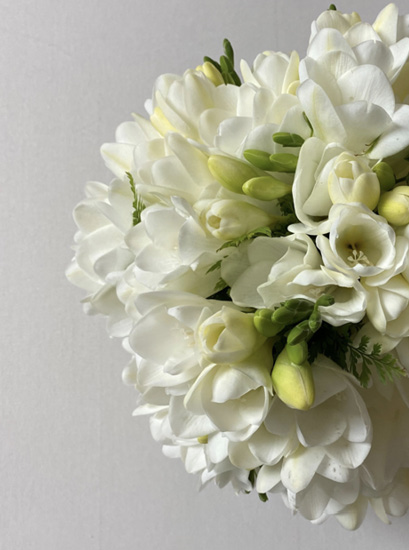
Freesia florets are indispensable for small-scale floral designs such as corsages, boutonnieres, and flower girl bouquets. We created a flower girl pomander with just a few ingredients: nylon tulle and florist’s cold glue. Both materials perform well in refrigeration, allow for speedy work, and create a pleasing design.
Here’s how to make your own flower girl pomander:
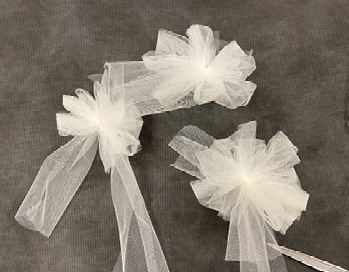
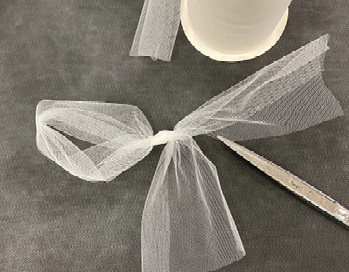
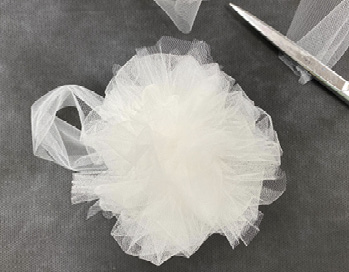
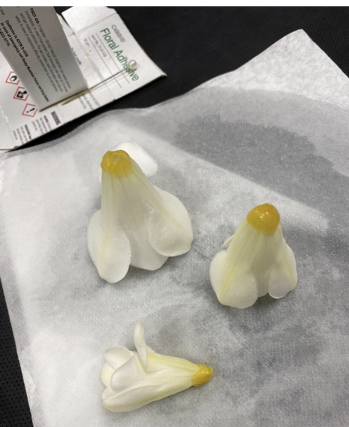

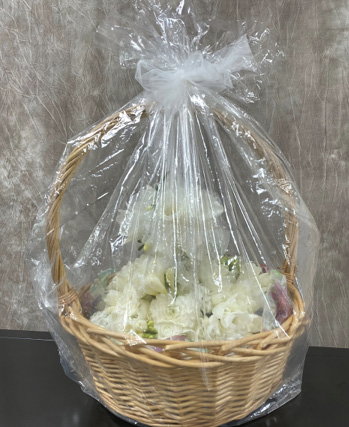
For teens and adults, make the pomander bouquet slightly larger. Consider this easy-to-carry design as an alternative to bouquets for dance recitals.
Flowers to Wear
Wiring and taping is a long-established mechanical technique in floral design. We encourage florists to practice and build aptitude in all techniques. When the occasions arise for the special arrangement of various types of flowers, the well-practiced florist remains comfortable and confident.
One to two stems of freesia can make a delicate corsage suitable for a shoulder, handbag, or wrist. This design also can be attached to a prayer book for a wedding ceremony.
We prepared five freesia florets using the hook wiring method and one cluster of tip buds using the wrap-around wiring method. A few glacier ivy leaves (Hedera helix ‘Glacier’) and small sprigs of boxwood (Buxus sempervirens) provide verdant green accents.
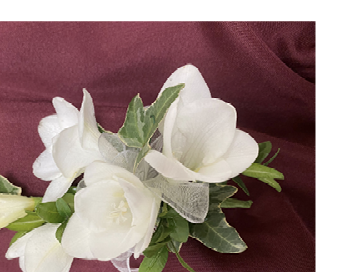
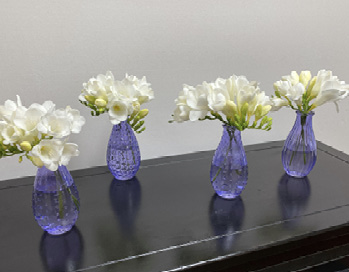

Table Arrangements
We are big fans of component floral designs—using multiple containers clustered together to create a tablescape. Just a few vases of freesia are all you need to complete a beautiful look. We placed three to four stems in each vase. This combination is fine for both rectangular and round tables; just arrange the vases to follow the tables’ lines.
Another approach is to join the vases with line material. Here, we have added horsetails (Equisetum hyemale) jutting from vase to vase. These dynamic lines change the effect of the composition, lending an architectural structure to the romantic combination of freesia bouquets.
References
Butler, S., DelPrince, J., Fowler, C., Gilliam, H., Johnson, J., McKinley, W., Money-Collins, H., Moss, L., Murray, P., Pamper, K., Scace, P., Shelton, F., Verheijen, A., & Whalen, K. (2008). The AIFD guide to floral design. Intelvid Group.
Dole, J., & Wilkins, H. (2005). Floriculture: Principles and species (2nd ed.). Pearson.
Longfield Gardens (n.d.) All about freesia. https://www.longfield-gardens.com/article/All-About-Freesia
Armitage, A., & Laushman, J. (2003). Specialty cut flowers: The production of annuals, perennials, bulbs, and woody plants for fresh and dried cut flowers (2nd ed.). Timber Press.
Scace, P., & DelPrince, J. (2021). Principles of floral design. Goodheart-Willcox.
Stevens, A. B., & Gast, K. L. B. (1992). Specialty cut flowers: A commercial grower’s guide. Kansas State University Cooperative Extension Service MF-1034.
Publication 3751 (POD-04-22)
By Anthony Bowden, Research Associate, South Mississippi Branch Experiment Station; James M. DelPrince, PhD, AIFD, PFCI, Associate Extension Professor, Coastal Research and Extension Center; Patricia Knight, PhD, Research Professor and Director of Coastal Horticulture Research; and Christine Coker, PhD, Associate Research Professor, Coastal Research and Extension Center.
The Mississippi State University Extension Service is working to ensure all web content is accessible to all users. If you need assistance accessing any of our content, please email the webteam or call 662-325-2262.



